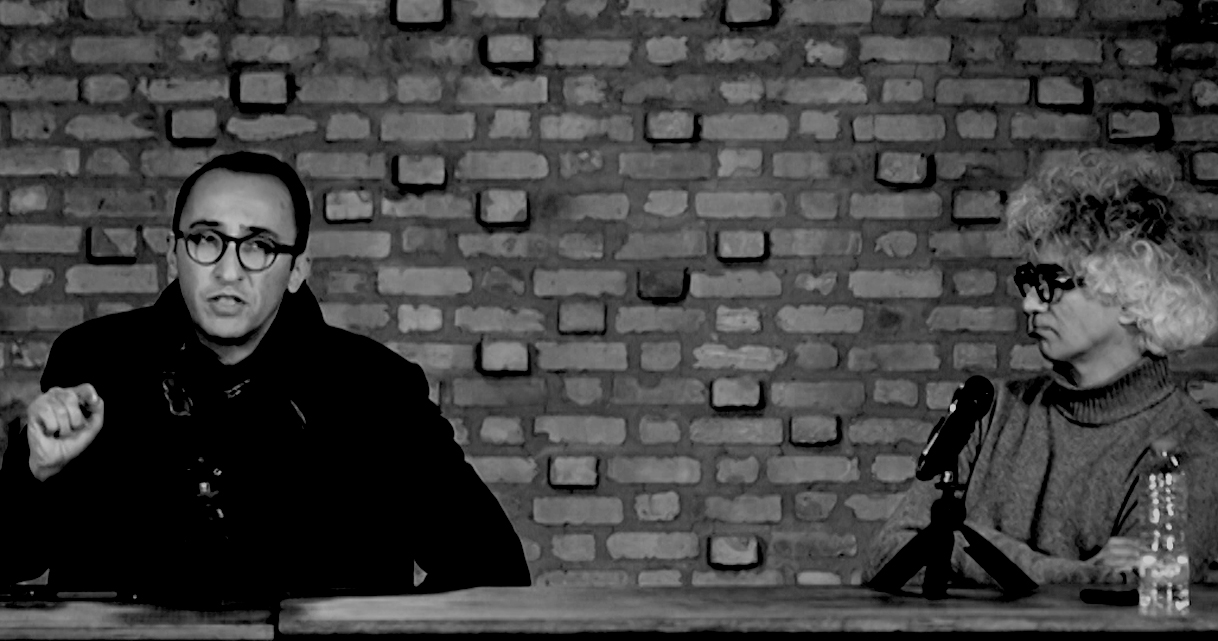Introduction
Taha Zaker began the discussion by expressing gratitude to the participants and audience, highlighting the extensive research and curation behind the project. He briefly acknowledged the curatorial efforts and logistical support before inviting the discussion to commence.
Section 1: The Purpose and Conceptual Foundation of the Project
• Mohammad Parvizi began by stating that Entertainment in Public is an ambitious and well-researched project that resists superficial interdisciplinary approaches. He critiqued many exhibitions that use “interdisciplinarity” as a mere label without real intellectual engagement.
• He emphasized that the power of an artwork lies in its ability to provoke a response and compel engagement—even when one attempts to ignore it.
• He highlighted a key argument: contemporary exhibitions often function more as social gatherings rather than critical spaces.
• Parvizi referenced Julia Kristeva’s view on history, arguing that art is significant only when it connects with historical trauma. He emphasized that Entertainment in Public does precisely that—it engages with collective wounds rather than treating them as detached narratives.
Section 2: Theoretical Debates on Interdisciplinarity and Categorization
• Parvizi voiced strong opposition to the term “interdisciplinary art,” arguing that artistic categories evolve naturally over time. He compared it to conceptual art, which was once an identifiable movement but later became a broader category without strict definitions.
• He referred to Gianni Vattimo, who argued that every phenomenon must be classified to be critically discussed.
• The discussion then transitioned into a debate on whether Entertainment in Public should be understood through intertextuality (relationships between texts) or interdisciplinarity (interactions between different artistic disciplines).
Behrang Samadzadegan’s Perspective:
• He agreed with Parvizi that traditional artistic labels are no longer functional, as contemporary art has moved beyond rigid stylistic categorizations.
• He introduced the idea of “Post-Historical” and “Post-Conceptual” eras, borrowing from Arthur Danto and Peter Osborne.
• He argued that in the post-historical era, artistic value is no longer determined by formal or stylistic qualities but by the creation of experience itself.
• Samadzadegan stressed that contemporary art goes beyond aesthetic or intellectual engagement—it creates immersive, physical experiences that actively involve the audience.
• He proposed that Entertainment in Public should be understood as an experiential, site-specific project rather than a conventional art form like painting or sculpture.

Section 3: The Function of Spectacle and Public Engagement
• Taha Zaker introduced the core argument of the project:
• He believes that image culture has become numb due to oversaturation and ease of reproduction.
• This realization led him to design an exhibition that minimized direct imagery, favoring spatial and performative experiences instead.
• He intentionally structured the exhibition to resist Instagram reproduction, ensuring that the full experience could only be grasped physically within the space.
• Parvizi responded critically:
• He argued that image itself is not dead, but desensitized due to excessive exposure.
• He suggested that rather than rejecting images altogether, artists must find ways to recharge images with meaning, ensuring they remain impactful.
• He referenced Walter Benjamin and Aby Warburg, discussing how historical images, even when detached from their original context, still carry emotional and cognitive power.
Section 4: The Politics of Public Punishment and Spectacle
• The panelists explored the historical and political dimensions of public punishment, drawing parallels between ISIS executions, medieval public spectacles, and contemporary media consumption.
• Zaker cited historical records of public executions in France, noting how crowds once called for the reinstatement of the gallows as a source of spectacle.
• Samadzadegan connected this to Susan Sontag’s critique of war photography, where images of suffering become a form of visual pornography, numbing the viewer rather than provoking critical engagement.
• The panelists debated whether Entertainment in Public successfully subverted this cycle or if it risked replicating the same spectacle it aimed to critique.
Section 5: The Role of Text and Context in Art
• Behrang Samadzadegan:
• He argued that textual elements in the exhibition functioned not as explanations but as integral artistic materials, contributing to the overall form.
• He referenced Roland Barthes’ theory of the “death of the author,” suggesting that the audience’s interpretation takes precedence over the artist’s intent.
• He defended the use of video essays in the exhibition, stating that they added contextual depth, preventing the project from becoming purely abstract.
• Mohammad Parvizi disagreed:
• He argued that an exhibition should function independently of text—otherwise, it risks becoming too dependent on external explanations.
• He used the example of an international visitor who doesn’t speak Persian—if they cannot understand the exhibition without reading, does the work still hold power?
• He emphasized the importance of an artwork’s ability to communicate beyond textual dependency, referencing Benjamin’s and Barthes’ theories on image reception.
Section 6: The Contemporary Role of Art in a Post-Aesthetic Era
• Samadzadegan concluded that we are no longer in an era where aesthetic criteria alone define artistic value.
• He argued that contemporary art must be understood through historical and contextual frameworks rather than formal beauty or medium-specific traditions.
• He emphasized that Entertainment in Public aligns with this post-aesthetic shift, prioritizing experience and interaction over conventional artistic forms.
Conclusion
• Parvizi stressed the importance of critical discussion in contemporary art, lamenting that many projects avoid serious critique.
• Zaker acknowledged the critiques, admitting that the project required a delicate balance between abstraction and direct engagement.
• The discussion ended with reflections on how contemporary art must continually question its relevance, particularly in an era of image saturation and digital reproduction.
Mohammad Parvizi, Behrang Samadzadegan, Taha Zaker
For the Full Video of the Panel Discussion, Visit the Link Below